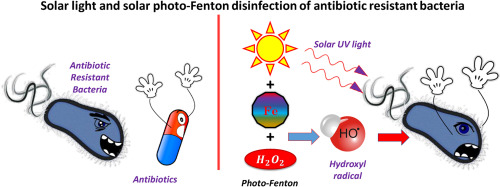Water Research ( IF 12.8 ) Pub Date : 2018-06-26 , DOI: 10.1016/j.watres.2018.06.062 Stefanos Giannakis , Truong-Thien Melvin Le , Jose Manuel Entenza , Cesar Pulgarin

|
The emergence of antibiotic resistance represents a major threat to human health. In this work we investigated the elimination of antibiotic resistant bacteria (ARB) by solar light and solar photo-Fenton processes. As such, we have designed an experimental plan in which several bacterial strains (Staphylococcus aureus, Escherichia coli and Klebsiella pneumoniae) possessing different drug-susceptible and -resistant patterns and structures (Gram-positive and Gram-negative) were subjected to solar light and the photo-Fenton oxidative treatment in water. We showed that both solar light and solar photo-Fenton processes were effective in the elimination of ARB in water and that the time necessary for solar light disinfection and solar photo-Fenton disinfection were similar for antibiotic-susceptible and antibiotic-resistant strains (mostly 180–240 and 90–120 min, respectively). Moreover, the bacterial structure did not significantly affect the effectiveness of the treatment. Similar regrowth pattern was observed (compared to the susceptible strain) and no development of bacteria with higher drug-resistance values was found in waters after any treatment. Finally, both processes were effective to reduce AR genes (ARGs), although solar photo-Fenton was more rapid than solar light. In conclusion, the solar photo-Fenton process ensured effective disinfection of ARB and elimination of ARGs in water (or wastewater) and is a potential mean to ensure limitation of ARB and ARG spread in nature.
中文翻译:

太阳光芬顿对11种抗药性细菌(ARB)进行消毒并消除了代表性的AR基因。抗生素耐药性并不意味着抗氧化治疗的证据
抗生素耐药性的出现对人类健康构成了重大威胁。在这项工作中,我们研究了通过太阳光和太阳光芬顿法消除抗生素抗药性细菌(ARB)。因此,我们设计了一个实验计划,其中使用了几种细菌菌株(金黄色葡萄球菌,大肠杆菌和肺炎克雷伯菌))对具有不同药物敏感性和耐药性的模式和结构(革兰氏阳性和革兰氏阴性)进行日光照射,然后在水中进行光芬顿氧化处理。我们表明,太阳光和太阳光芬顿过程均能有效消除水中的ARB,并且对抗生素敏感和抗药性菌株,太阳光消毒和太阳光芬顿消毒所需的时间相似(大多数为180 –240分钟和90–120分钟)。而且,细菌结构没有显着影响治疗效果。观察到相似的再生模式(与易感菌株相比),经过任何处理后在水中均未发现具有较高耐药性的细菌的发育。最后,尽管太阳光芬顿比太阳光更快,但这两个过程都有效地减少了AR基因(ARG)。总之,太阳光芬顿法确保了对ARB的有效消毒并消除了水(或废水)中的ARG,这是确保限制ARB和ARG在自然界传播的一种潜在手段。



























 京公网安备 11010802027423号
京公网安备 11010802027423号